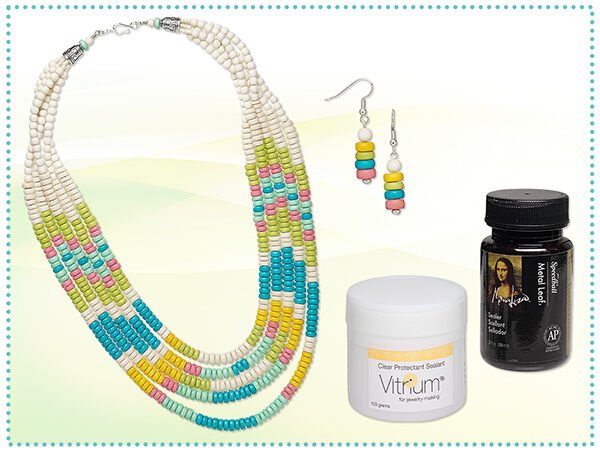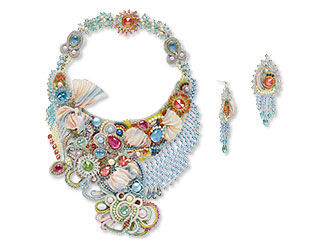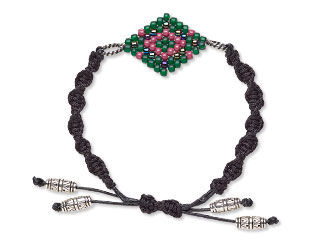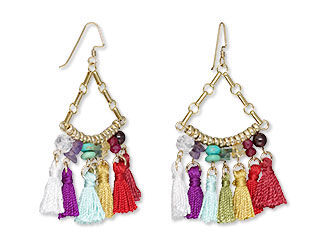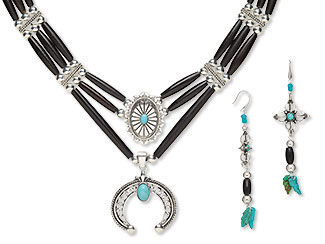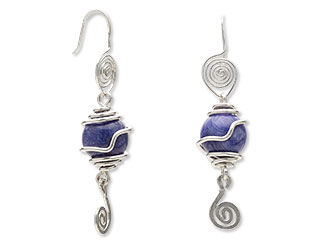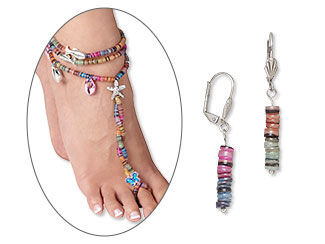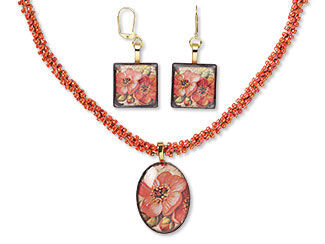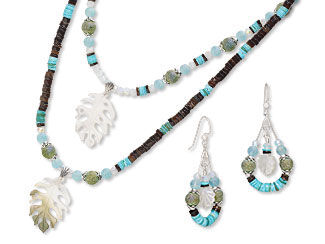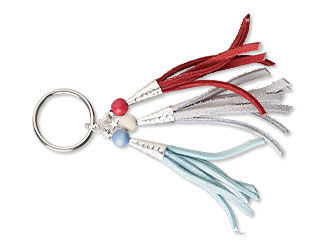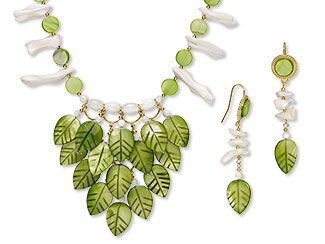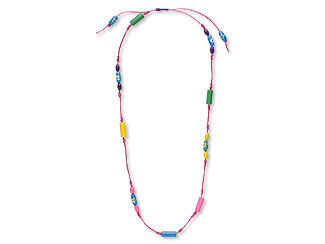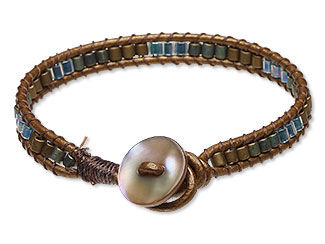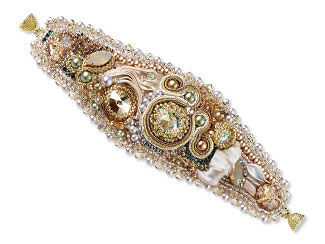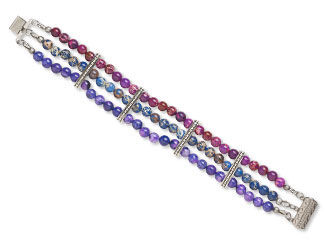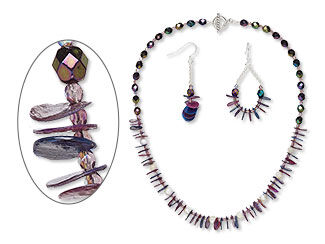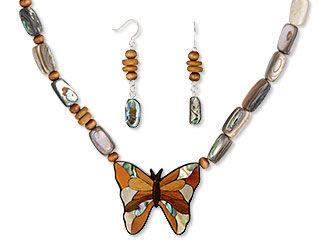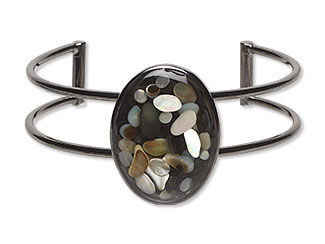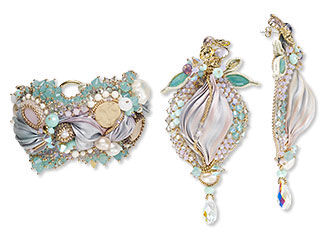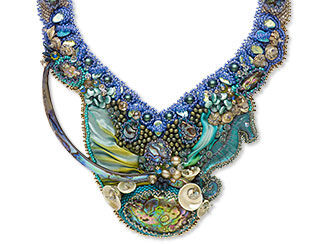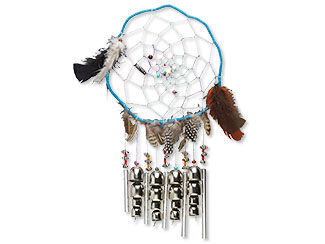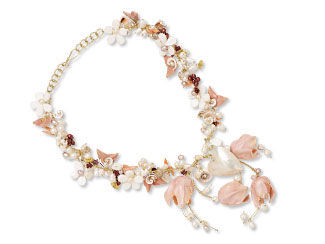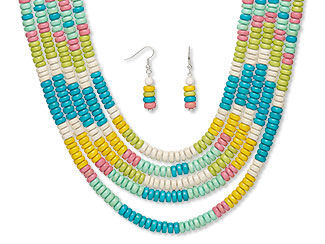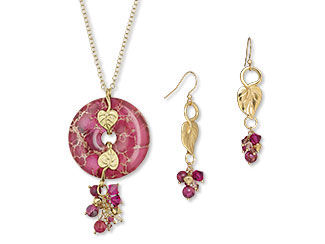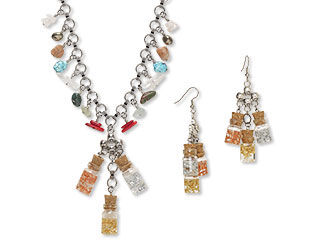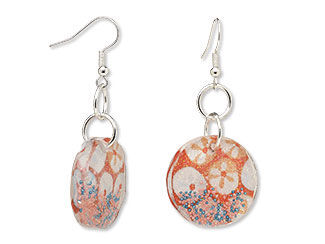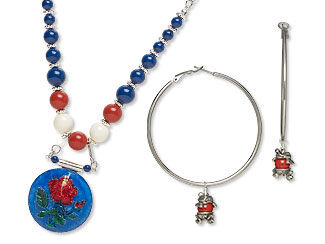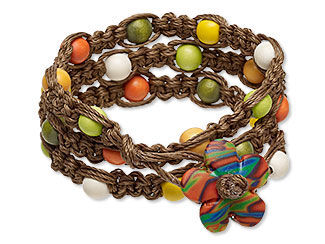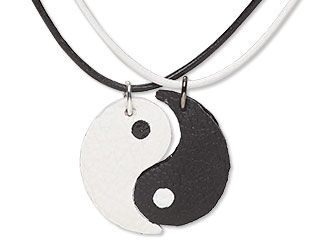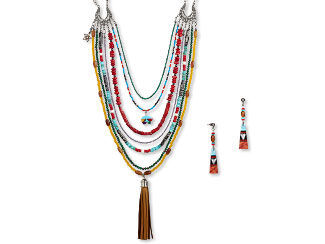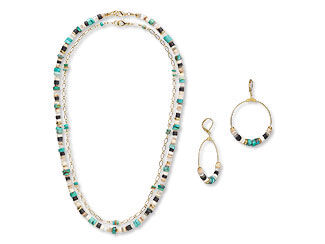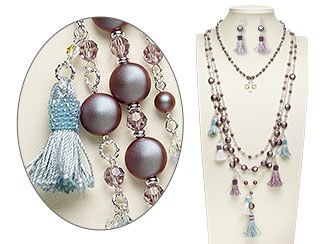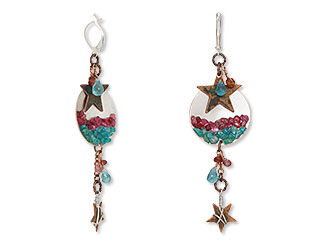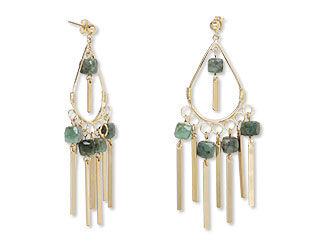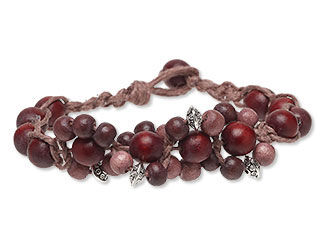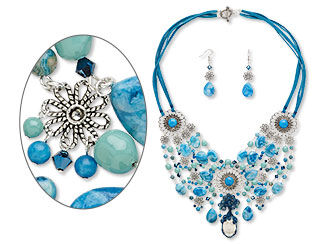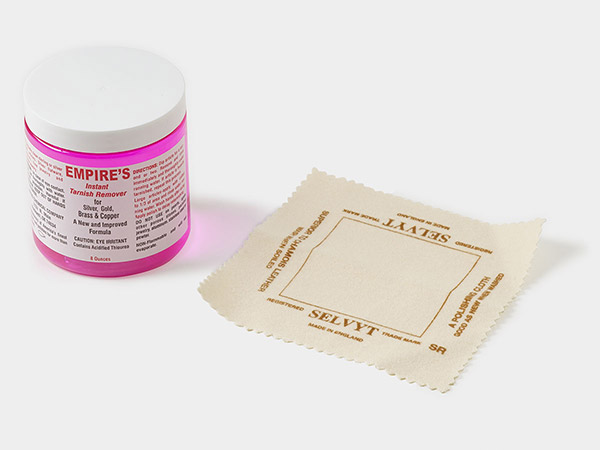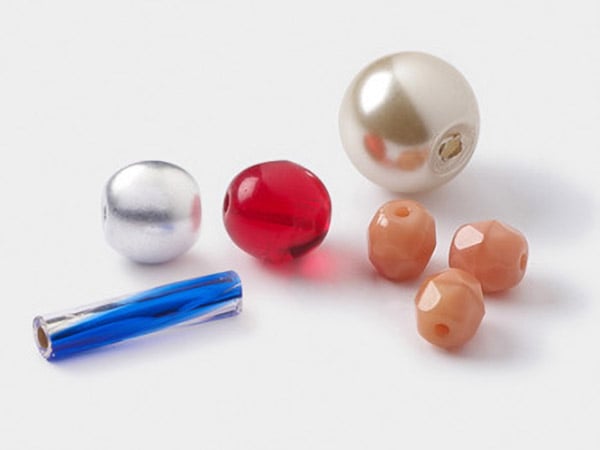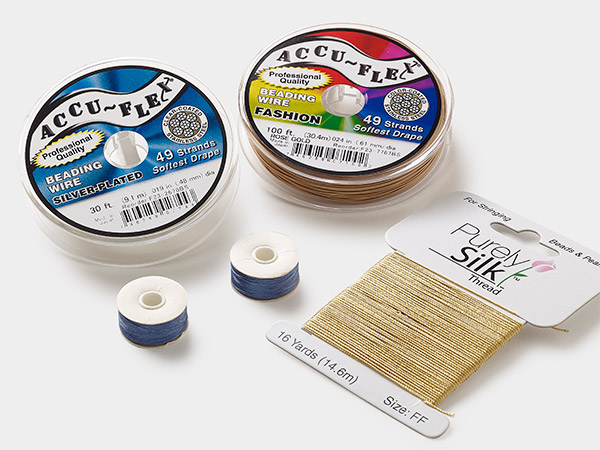Colorfastness in Beads and Jewelry-Making Supplies
Beads can bleed. Color bleed, that is. That can affect your design choices.
Colorfastness is the durability of color—it's whether colors fade and/or bleed into surrounding materials (or a customer's skin). Here, you'll find ways to identify which beads and other jewelry-making supplies are colorfast and which are not, as well as have tips for protecting color in your creations.
Don't let your beads bleed.
Different Types of Colorfastness
Fire Mountain Gems and Beads notes when beads and other jewelry-making supplies may not be colorfast and recommends testing by the jewelry maker to determine if colors are durable for their intended use.
Most commonly, these are materials that have been dyed, and a majority of them are gemstones. Other materials include colorful items made of acrylic or polyester, plus organic materials such as bone, cotton, horn, pearl, shell, silk and wood. These are typically marked with the enhancement code of (dyed) or (D). Other materials which are not colorfast may have been coated with a color—marked as (coated) or (C)—or have a painted surface. A few will have wax—marked as (waxed) or (W)—where the color is in the wax that is coating the surface or impregnated into the outer layers of the material.
In addition, different materials and different dyes have different types of colorfastness. Water may not affect one form of colorfastness, but perspiration would. Cold water may not affect this form of colorfastness, but a hot shower does. Friction or rubbing may not affect that form of colorfastness, but chlorinated water from a swimming pool absolutely can.
Different colors tend to have different color longevities, as well: darker colors are often less colorfast than pale ones, reds and pinks fade faster than other colors, etc. The same applies to different materials. Products change through time, as well. Older stock of some satin cording may not be colorfast, but newer spools are labeled as colorfast and AZO-free. Check original product numbers and descriptions wherever and whenever you buy. At Fire Mountain Gems and Beads, products with the tag "Testing for colorfastness is recommended" should be tested against any or all of these challenges:
1. Colorfastness to Water
This is important even if you do not live in a rainy place like Seattle! Plain tap water can leech color from beads and components. As it is the most common loss of color in jewelry-making supplies, it should be your first test. Materials that are sensitive to color bleeding should be avoided for resort collections and sports designs, as they shouldn't get wet in any way, including rain and perspiration. Here are a few ways to check for water colorfastness in your beads and other jewelry-making materials:
- Lay a few beads—or a thumb's length of other materials—on a damp white towel and wait a few minutes. If there is even a faint ring of color where the item was, it is not colorfast.
- Place your samples into lukewarm soapy water, stir occasionally and watch for a color change in the water
2. Colorfastness to Salt Water/Seawater
Salt is frequently added to water to "fix" or "set" color in textiles, yet it is notorious for removing dyes from hair. Seawater contains faint traces of a range of elements and some of those elements can bind to dyes and skew or strip color, depending on the dye type used.
Test whether a jewelry-making material is colorfast to salt water by mixing approximately 2 level teaspoons of sea salt into 1 cup of non-chlorinated water. Use a cotton swab to dab a bit on your testing item. Wait 30 minutes to see if the colors react. If your designs are created for use on the beach, try to get a sample of seawater from that area to test with instead. Long-term exposure of organics to seawater is known to cause drying, so materials may need to be oiled or remoisturized appropriately if exposed. Opal, emerald and amber are especially vulnerable.
If the color changes, you may need to make different design choices or use a sealant.
3. Colorfastness to Chlorinated Water
Chlorine is an alkaline frequently added to water to remove color from textiles, as well as sanitize swimming pools and drinking water.
To test whether a jewelry-making material is colorfast to water with chlorine in it, use a cotton swab to dab a bit of chlorinated water on your testing item. Wait 30 minutes to see if the colors react. Chlorine is especially damaging to fibers and textiles such as nylon (Nymo® thread and Satinique™ cord), polyester (parachute cord and Beadalon® WildFire™) and cultivated silk (Griffin and Purely Silk™ thread and cord). Test on scraps and samples—and don't forget to check your seed beads!
If the color changes, you may need to make different design choices or use a sealant.
4. Colorfastness to Perspiration
Perspiration can be both acidic and alkaline, depending on the individual. Much like underarm stains, perspiration can affect the color of jewelry materials, either bleaching them out or rendering them darker.
To test whether a jewelry-making material is colorfast to perspiration, you need to create both an acidic solution (plain white household vinegar will do) and an alkaline solution (household bleach or household ammonia works here). Do not mix them! Use a cotton swab to dab a bit of each to your testing bead, component or stringing material. Wait 30 minutes to see if the colors react.
If the color changes, you may need to make different design choices or use a sealant.
5. Colorfastness to Friction/Rubbing
In the textile world, this kind of color loss is called "crocking" and is commonly seen when wearing brand new blue jeans while sitting on a white cushion.
Test using a dry cloth and a damp cloth and gently rub on a bead or component where it won't show when used in a design. Some colors rub away easier than others and can rub away at different intensities on the same piece—especially if the dyed material is organic. Some seed bead finishes will rub off under high friction. Miyuki has a durability chart for its Delica line. Other Miyuki and Preciosa Ornela seed bead finishes have a separate durability chart.
You may need to avoid offering certain materials as bracelets or anklets due to their high sensitivity for friction and rubbing.
6. Colorfastness to Heat and/or Pressing
Heat can cause colors to fade, which is why steam cleaners are only recommended for plain metal and certain gemstones. For example, amethyst can be turned into citrine with the application of heat—which is why many citrine stones are marked as (heated) or (H) to indicate they began as a different form of quartz. And that's why most cleaning instructions direct jewelry makers to use lukewarm water and a soft cloth to clean their designs.
When cleaning or pressing (ironing) embellished textiles, this can cause problems. Be sure to test the effects of heat on both the textile and the beading supplies before you embellish.
7. Colorfastness to Washing in Water
This is especially vital to know and test if you are embellishing textiles. Washing in water can combine multiple colorfastness challenges, including water, friction, heat and changes in pH due to detergents.
Embellished garments can frequently need specialized care. Test your cleaning methods on an unobtrusive area of on both the textile and your jewelry-making materials before you use them to embellish clothing and do all that work. You'll save yourself frustration and be able to provide customers with the proper cleaning and care instructions. It's an easy and sensible way to increase customer retention.
8. Colorfastness to Light
Light, especially full-spectrum daylight, can bleach the color from beads and components. Rose quartz and kunzite are particularly known to fade in sunlight. This fact makes these stones less ideal as the pink element in summertime jewelry designs and imprudent as a choice in suncatchers or windchimes.
A good way to test light colorfastness is to take one of two sample beads and put it on your windowsill in the sunlight. Store the second in a dark drawer of your bead stash. Leave for 1-4 weeks, depending on the intensity of local light (Arizona designers will need less time than Saskatchewan designers). At the end of that time period, compare both beads.
If color has faded in such a short time, you may need to reevaluate your material choices.
Be aware that many household products may affect colorfastness, in addition to the structure or surface of a gemstone. Organic gems such as pearl and soft stones such as turquoise are especially sensitive. Acetone—popularly used to remove nail polish—can remove other color coatings. Rubbing (isopropanol) alcohol, ammonia, vinegar, peroxide and baking soda can affect jewelry-making materials, depending on the type of colorant used on those items. Do not combine household products! They can become deadly when mixed. Always use gloves, protective clothing and eye protection when testing colorfastness.
Stabilizing Color and Preserving Colorfastness
So, you've discovered that some beads and components in your stash aren't colorfast. What happens next depends on what you want.
Do you want the color revealed by any of the tests—or do you prefer the original color? Either way, you'll need to stabilize that color. Here are some ways to stabilize color in your jewelry-making supplies and preserve their colorfastness.
1. Stabilizing Colorfastness Against Water
There are two ways to stabilize color against water: "fixing" or "setting" the color using a mordant and sealing the bead with a clear top coat.
- Fix the Color
"Fixing" or "setting" color works best with organic materials: natural fibers such as silk and cotton, as well as bead materials like wood, seeds, shell and pearls. One of the most popular color "fixers" (also called mordants) is white household vinegar. This liquid is a mild acid, so you'll need to test your bead surface in an area that won't show in a design. Vinegar helps set color in wool, silk and nylon textiles and will work similarly on thread and cord in those materials. Avoid using vinegar on pearls, mother-of-pearl, limestone, marble, shell and other beads which contain calcium.
Another popular and inexpensive "fixer" is plain salt. Salt helps set color in cotton and will work similarly on thread and cord in that material. Avoid using salt on items with metal components, especially carbon steel, aluminum, brass and other copper alloys.
If your beads or supplies are high-end, you can invest in professional dye fixatives from companies like Rit®, iDye, Hewit or Tulip. Be sure to read and follow all disposal instructions thoroughly.
Some dyes will react to these fixer solutions. Some will not. It depends on what kind of dye was used and what material has been colored. - Seal the Bead
If you cannot fix the color into the material, then you need to seal the bead or component. (Sealing is less applicable to stringing materials as it can compromise their flexibility.) We recommend Mona Lisa™ Metal Leaf™, Vitrium® Clear Protectant or PermaLac®NT top coat sealants. Note that all will give you a glossy finish.- Using a clean cloth, carefully wipe or blot any dirt or oil residue from items
- Apply a thin coat of sealant with a paintbrush and let dry overnight
Some jewelry makers try to economize by using clear nail polish to seal color. Be sure to test the nail polish on an area of the bead or component which will not show during use, so unexpected chemical reactions do not occur between the polish and the dyes. Top coat sealants should not be used on pearls, as they can reduce the luster or crack the surface. Instead, you can re-dye the pearls for stronger color and use some of the dye fixing ideas above. - Using a clean cloth, carefully wipe or blot any dirt or oil residue from items
2. Stabilizing Colorfastness Against Friction/Rubbing
There are two techniques you can use to stabilize color against the damage done by friction.
- Seal the Bead
Seal the bead or component using clear sealants, as above. - Avoid High-Friction Designs
To prevent coatings from rubbing off, even after sealing the bead or component, it is best to use these materials in low-friction jewelry such as earrings or pendants. When using friction-vulnerable components, avoid bracelets, anklets, finger jewelry and toe rings.
3. Stabilizing Colorfastness Against Light, Heat and/or Pressing
- Appropriate Cleaning and Pressing
Clean jewelry with dry polishing cloths rather than liquid cleaners. Spot clean, hand wash and do so all with cool to lukewarm water. Avoid ironing embellished textiles and accessories. If you must press them, use the lowest heat setting and shortest press time possible.
- Appropriate Storage
Keep your supplies and completed designs stored in a cool, dark place to prevent color shifting or fading. Keeping sensitive materials out of the heat and out of the sunlight will prevent color fading.
For some designers, colors must not fade in jewelry over time. For others, the slow change of color over time is part and parcel of their design effect—like the difference between new dark blue denim and the faded blue of well-loved jeans. It all depends on your brand aesthetic.
Use these guidelines to test what you use before you use it, and protect your customers and designs after.
Shop for Your Materials Here:
Have a question regarding this project? Email Customer Service.
Copyright Permissions
All works of authorship (articles, videos, tutorials and other creative works) are from the Fire Mountain Gems and Beads® Collection, and permission to copy is granted for non-commercial educational purposes only. All other reproduction requires written permission. For more information, please email copyrightpermission@firemtn.com.
